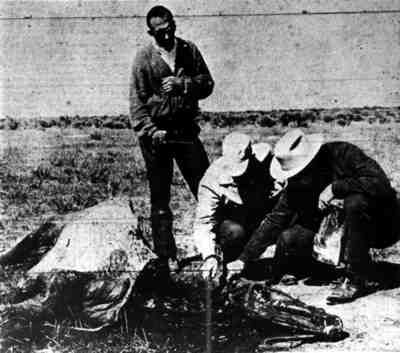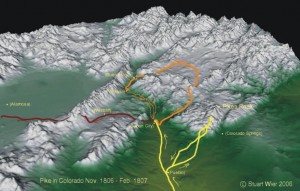Article by Kenneth Jessen
History – March 2007 – Colorado Central Magazine
0N A CLEAR SEPTEMBER night in 1967, a flying saucer descended in the San Luis Valley, and according to some residents, this was almost a daily occurrence then. This spaceship had the traditional (for a flying saucer) pulsating red, green, and white lights, and landed on the King Ranch about twenty miles northeast of Alamosa. The curious aliens wanted to examine a horse and they picked Snippy.
First they slit the three-year-old gelding’s throat, then they skinned the head and neck, removing the flesh down to the bone. The fiendish invaders sucked out the animal’s brains and spinal fluid, and finally, they ended their bizarre ritual by removing some of the animal’s organs, presumably for later examination.
The weight of their spaceship crushed a small bush. Its landing pads left a ring of indentations in the earth, and when it took off, exhaust burns could be seen around the carcass. There was also a strange chemical odor permeating the air, and naturally the area was hot with radiation.

Mrs. Agnes King, eighty-seven years old at the time of the incident, saw the flying saucer pass over her house on the King Ranch the day of Snippy’s death. Mrs. Berle Lewis, Snippy’s owner, reported that a UFO landed and that its occupants killed her gelding in a most unusual fashion. “They’re here,” Mrs. Lewis stated, “There’s no question about that … I know they are real, and a lot of people think I’m nuts. But if I am nuts, it is because of the flying saucers … I’m sure they are here. I’ve seen them.” After Mrs. Lewis touched the remains of her horse, she experienced a burning sensation on her hands, and her boots became radioactive after she entered the area.
The Lamar Daily News, October 13, 1967, reported, “A nuclear physicist, a psychologist, and an animal expert have been dispatched to the remote San Luis Valley, where some residents see unidentified flying objects more often than they see their neighbors.”
A memorial fund was started to finance a monument to Snippy. A plaque was to be purchased to mark the spot where the historic event took place. In addition, a fiberglass statue of Snippy was to be placed in the Alamosa city park.
But a Colorado State University professor offered an alternate theory on how Snippy died. Dr. O. Robert Adams of the Veterinary College examined the carcass and showed that the horse had an infection in its right flank which probably killed him. Dr. Adams speculated that someone found the suffering horse and cut its throat to put it out of its misery. Predators cleaned the head and neck and removed the organs. In the heat of the day, the brain and spinal fluid evaporated. The darkened “exhaust” marks around the animal could be attributed to nothing more mysterious than dried blood. The individual taking the Geiger counter readings was not trained and the instrument was out of calibration. Radiation levels measured later with a calibrated instrument were perfectly normal.
But what about the circle of indentations and the crushed bush? Robert Fenwick, a Denver Post columnist, advanced another theory: Snippy could have been the victim of an old-fashioned slaughter with a prankish twist. Fenwick speculated that Snippy was felled by a tranquilizer gun, and then strung up, hind legs first. The horse was suspended on a pole rig resembling a tepee. This left the circle of indentations in the ground. After slashing the horse’s throat, the head and neck could have been lowered into a bucket of acid. This would have removed the skin and flesh, right down to the bone. Splattered acid would account for the “exhaust” marks around the carcass. The burning sensation experienced by Mrs. Lewis could have come from the acid.
SNIPPY’S REMAINS LAY ROTTING from September to December. By that time, the carcass was pretty ripe. Dr. Wallace Leary, operator of the Valley Veterinary Clinic, asked Mrs. Lewis if he could have Snippy’s remains. Using a pickup truck, Dr. Leary moved the carcass to his clinic. He left it on his roof, hoping that additional weathering would aid in separating the rotting flesh from the bones. After two weeks, Leary ended up with the frozen horseflesh. Using a large cauldron, Leary boiled the parts of the horse and recovered the bones. During this process, he found .22 caliber bullets in the left pelvis and in the right thigh bone. Either wound could have caused the infection that probably killed Snippy.
After the bones were dry, Dr. Leary drilled and connected them with wire. A local machine shop built a platform with supporting aluminum rods. Snippy’s skeleton was mounted in a standing position and placed outside a pottery shop on U.S. 285 west of Alamosa.
But UFO tales don’t die easily. A year after the incident, Mrs. Lewis reconfirmed her belief that her horse was the victim of extraterrestrial killers. A student at Kearney State College in Kearney, Nebraska, wrote Dr. Adams a “hate letter” after the report on how Snippy died of natural causes was published. The letter reads:
I have been exhaustively studying the phenomena known as “flying saucers” now for five years. True there have been many false reports, but from the knowledge I now possess, I think you are being paid by the Air Force /Blue Coats to debunk the saucer theory.
My only question is this: How much are they paying you, or is there some other type of pressure they are bringing to bear.
P.S. Please answer this letter because I really would like to know “the system.”
Dr. Adams handled the reply in his usual professional manner and was later commended by Colorado State University’s vice-president for the excellent job he did in representing the school.
Snippy is not forgotten. Recently, the bones were put up for sale on eBay, which prompted a “Save Snippy Fund” supported by the Alamosa Chamber of Commerce. (See the February 2007 Colorado Central for more details.)
Kenneth Jessen lives in Loveland and has written many books about Coloado’s hstory and lore.


